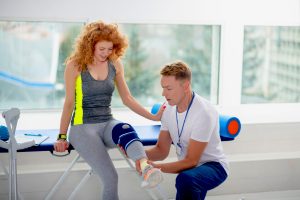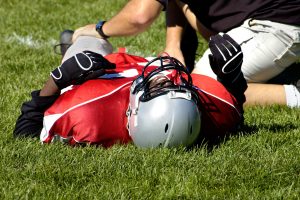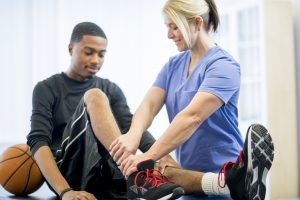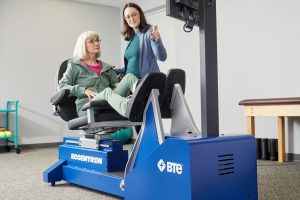
Operative or Non-operative ACL Rehab? It Depends…
Treatment GuidelinesThe common “What should I do?” can stop us in our tracks. The answer is... it depends. What exactly does the answer depend on? Can non-operative ACL rehab work for high-level athletes? Or is surgery necessary for a full return to intense sport?
The anterior cruciate ligament (ACL) has been cited as the most injured ligament in the knee1. 100,000-200,000 ACL injuries take place each year, but we know that not all of these patients will opt for ACL repair or reconstruction2.
In clinical practice, we often have patients seeking advice after an injury. The common “what should I do?” question can sometimes stop us in our tracks. My own tendency is to respond with the classic “it depends” answer.
This leads us to the topic of this article. What exactly does the answer depend on? Can non-operative ACL rehabilitation be appropriate for high-level athletes? Or is repair or reconstruction necessary for a full return to intense sport?
ACL Repair and Reconstruction
The rate of ACL reconstruction has increased exponentially in recent years with 75-90% of patients reporting good postoperative outcomes. Although this surgery is common, there are still certain criteria surgeons consider when deciding if a patient is a candidate for reconstruction. These criteria include the mechanism of injury, specific symptoms, and imaging results. Additionally, knee function, special testing, and gait should be taken into consideration3.
ACL reconstructions can be conducted using a wide variety of grafts, including a patellar tendon autograft, hamstring autograft, or an allograft. Each comes with advantages and disadvantages, and what type of ACL graft is best is its own topic of great debate.
As common as ACL reconstruction is, there are disadvantages that can accompany this procedure. For example, ACL reconstruction failure rate hovers around 10-15% and is generally due to traumatic or technical causes3.
Other complications include pain, infection, stiffness, concomitant injury, or malalignment4. Another postsurgical concern, osteoarthritis (OA), is highly prevalent among those who undergo ACL reconstruction.
These considerations, among others, may cause concern for injured athletes. However, reconstructive surgery may not be their only option for recovery after ACL injury. Conservative treatment is a rehabilitative path chosen by many, although it is worth looking into the pros and cons of this rehabilitation approach.
Non-operative ACL Rehabilitation
Conservative ACL rehab is not a new concept, but it has been gaining attention online and on social media over the last few years. For many athletes, this can seem like a favorable alternative to surgery. However, it’s worth reviewing the current research before jumping to conclusions.
Physical therapy is a field that varies widely, both between settings and between providers. This variability can make research difficult regarding long-term outcomes. However, some recent studies suggest there may be little difference in outcomes between operative and non-operative ACL treatment in the long term5.
A major factor in determining the appropriateness of conservative ACL management is the degree of the tear and resulting knee laxity. Patients with grade-one laxity on the Lachman and Pivot Shift testing had 90% success rate following conservative treatment at the one-year follow up. On the contrary, patients with grade-two laxity had a greater chance of requiring eventual ACL reconstruction5.
Patients who choose a non-operative approach have been found to have quicker returns to level two and three sports. Additionally, patients who wished to return to non-competitive or non-contact sporting activities were generally satisfied with non-operative ACL management5.
E-book: ACL Recovery with Eccentric Strengthening and Motor Control
Optimizing ACL rehab requires staying informed about the latest advancements. The e-book ACL Recovery with Eccentric Strengthening and Motor Control by BTE offers valuable insights to support your clinical decision-making.
It focuses on eccentric strengthening with the Eccentron, which targets the lengthening phase of muscle contractions and plays a crucial role in ACL recovery. The e-book also emphasizes motor control, aiding in the retraining of movement patterns and optimizing neuromuscular control for athletes. This comprehensive resource provides research, case studies, exercise protocols, and expert advice to guide you through each stage of ACL rehab. Download the e-book below.
Current Evidence
During the initial follow-up period post-surgery, one study found improved knee stability in those who underwent ACL reconstruction5. However, 10 years later both the conservative and surgical intervention groups showed similar outcomes regarding knee stability6.
With that said, individuals who experience complete ACL ruptures generally have a poorer prognosis without surgical intervention5. This leads us back to the idea that the degree of tear and associated knee instability are generally the drivers for operative vs. non-operative ACL intervention.
As mentioned earlier, osteoarthritis is a major concern for those who experience knee trauma, specifically ACL injury. In past years, it has been suggested that ACL reconstruction can decrease the likelihood of OA development in the knee. Recent studies, however, suggest that it is the presence of an ACL injury alone that most determines OA development.
A 57% incidence of knee OA was found in those 14 years post ACL reconstruction surgery3. This varies little from those who undergo conservative treatment. While ACL reconstruction may not decrease OA risk, it can potentially decrease the risk of secondary meniscus or cartilage injury1.
Another recent study compared operative and non-operative ACL outcomes for high level athletes at a 20-year follow-up. Knee osteoarthritis was found in 80% of the operative group and 68% of the non-operative group7. While those who underwent non-operative ACL management presented with greater knee instability at this follow-up, subjective and objective functional outcomes were comparable7.
Emphasis on Education
There is a huge amount of varying research and information regarding operative and non-operative ACL treatment. This can become overwhelming for athletes and clinicians alike as there are so many “it depends” factors involved.
Based on the research summarized in this article, patient education is key to making the decision between operative and non-operative ACL treatment. We’ve seen that incidence of OA is comparable between these two approaches, but differences in knee laxity have been found between the groups. Additionally, degree of tear and goals for return to sport play a large role in this decision-making process.
Athletes with complete tears will generally require ACL reconstruction. Similarly, those with smaller tears with a large degree of laxity or instability may find surgical intervention to be their best course of treatment. Return to sport is another important factor when making this decision. Athletes returning to higher level sport (cutting, jumping, contact sports, etc.) may require the stability provided by operative treatment.
Athletes with lower grade tears or knee stability that is largely intact may be able to pursue conservative treatment with great success. Although return to sport can be possible for all levels with non-operative ACL treatment, those returning to lower level, non-competitive, or non-contact athletics are often excellent candidates for conservative treatment.
Prehab is a Priority
Regardless of whether an athlete chooses operative or non-operative ACL treatment, recent research has highlighted the importance of “prehab.” In one systematic review, athletes who underwent prehabilitation demonstrated less postoperative decline in quadriceps strength and single-leg hop distance8.
Additionally, those who participated in prehab were found to have greater return to sport rates and increased self-reported knee function at a two-year follow-up8. Dedication and consistency with rehab exercises is key for all athletes following ACL injury. However, those who choose surgical intervention can maximize their recovery and return to sport potential by kickstarting their recovery prior to surgery.
ACL injury can be devastating for athletes of all types and comes with a lengthy recovery process. However, clinicians can help provide patients with education regarding surgical and conservative treatment options. In turn, this can help patients sort through the vast amount of information on the internet and choose a treatment plan that can help them get back in the game.
Mariah Kellogg, PT, DPT is a Physical Therapist and health writer. Her career focuses on rehabilitation for neurological and orthopedic populations and she is passionate about patient advocacy. Mariah began her career in Alaska and uses writing as a tool to inspire patients to pursue their health goals as well as to engage with other clinicians about rehab topics.
References
- Cheung EC, DiLallo M, Feeley BT, Lansdown DA. Osteoarthritis and ACL Reconstruction-Myths and Risks. Curr Rev Musculoskelet Med. 2020 Feb;13(1):115-122. doi: 10.1007/s12178-019-09596-w. PMID: 31894466; PMCID: PMC7083996.
- Evans J, Nielson Jl. Anterior Cruciate Ligament Knee Injuries. [Updated 2022 May 5]. In: StatPearls [Internet]. Treasure Island (FL): StatPearls Publishing; 2023 Jan-.Available from: https://www.ncbi.nlm.nih.gov/books/NBK499848/
- Samitier G, Marcano AI, Alentorn-Geli E, Cugat R, Farmer KW, Moser MW. Failure of Anterior Cruciate Ligament Reconstruction. Arch Bone Jt Surg. 2015 Oct;3(4):220-40. PMID: 26550585; PMCID: PMC4628627.
- Tjoumakaris FP, Herz-Brown AL, Bowers AL, Sennett BJ, Bernstein J. Complications in brief: Anterior cruciate ligament reconstruction. Clin Orthop Relat Res. 2012 Feb;470(2):630-6. doi: 10.1007/s11999-011-2153-y. Epub 2011 Nov 16. Erratum in: Clin Orthop Relat Res. 2012 Apr;470(4):1241. Legath-Bowers, Andrea [corrected to Bowers, Andrea L]. PMID: 22086506; PMCID: PMC32547
- Rodriguez K, Soni M, Joshi PK, Patel SC, Shreya D, Zamora DI, Patel GS,Grossmann I, Sange I. Anterior Cruciate Ligament Injury: Conservative Versus Surgical Treatment. Cureus. 2021 Dec 6;13(12):e20206. doi: 10.7759/cureus.20206. PMID: 35004026; PMCID: PMC8730351.
- Meuffels DE, Favejee MM, Vissers MM, Heijboer MP, Reijman M, Verhaar JA. Ten year follow-up study comparing conservative versus operative treatment of anterior cruciate ligament ruptures. A matched-pair analysis of high level athletes. Br J Sports Med. 2009 May;43(5):347-51. doi: 10.1136/bjsm.2008.049403. Epub 2008 Jul 4. PMID: 18603576.
- van Yperen DT, Reijman M, van Es EM, Bierma-Zeinstra SMA, Meuffels DE. Twenty-Year Follow-up Study Comparing Operative Versus Nonoperative Treatment of Anterior Cruciate Ligament Ruptures in High-Level Athletes. Am J Sports Med. 2018 Apr;46(5):1129-1136. doi: 10.1177/0363546517751683. Epub 2018 Feb 13. PMID: 29438635.
- Giesche F, Niederer D, Banzer W, Vogt L. Evidence for the effects of prehabilitation before ACL-reconstruction on return to sport-related and self-reported knee function: A systematic review. PLoS One. 2020 Oct 28;15(10):e0240192. doi: 10.1371/journal.pone.0240192. PMID: 33112865; PMCID: PMC7592749.





